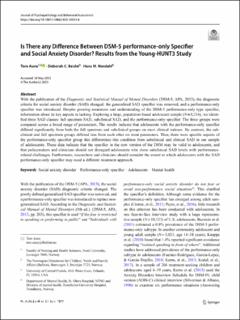| dc.contributor.author | Aune, Tore | |
| dc.contributor.author | Beidel, Deborah C. | |
| dc.contributor.author | Nordahl, Hans Morten | |
| dc.date.accessioned | 2023-07-24T11:00:24Z | |
| dc.date.available | 2023-07-24T11:00:24Z | |
| dc.date.created | 2023-06-26T09:32:41Z | |
| dc.date.issued | 2023 | |
| dc.identifier.citation | Journal of Psychopathology and Behavioral Assessment. 2023, . | en_US |
| dc.identifier.issn | 0882-2689 | |
| dc.identifier.uri | https://hdl.handle.net/11250/3081106 | |
| dc.description.abstract | With the publication of the Diagnostic and Statistical Manual of Mental Disorders (DSM-5, APA, 2013), the diagnostic criteria for social anxiety disorder (SAD) changed; the generalized SAD specifier was removed, and a performance-only specifier was introduced. Despite growing awareness and understanding of the DSM-5 performance-only type specifier, information about its key aspects is lacking. Exploring a large, population-based adolescent sample (N = 8,216), we identified three SAD classes: full spectrum SAD, subclinical SAD, and the performance-only specifier. The three groups were compared across a broad range of parameters. The results indicate that adolescents with the performance-only specifier differed significantly from both the full spectrum and subclinical groups on most clinical indexes. By contrast, the subclinical and full spectrum groups differed less from each other on most parameters. Thus, there were specific aspects of the performance-only specifier group that differentiate this condition from subclinical and clinical SAD in our sample of adolescents. These data indicate that the specifier in the new version of the DSM may be valid in adolescents, and that policymakers and clinicians should not disregard adolescents who show subclinical SAD levels with performance-related challenges. Furthermore, researchers and clinicians should consider the extent to which adolescents with the SAD performance-only specifier may need a different treatment approach. | en_US |
| dc.language.iso | eng | en_US |
| dc.publisher | Springer | en_US |
| dc.rights | Navngivelse 4.0 Internasjonal | * |
| dc.rights.uri | http://creativecommons.org/licenses/by/4.0/deed.no | * |
| dc.title | Is There any Difference Between DSM-5 performance-only Specifier and Social Anxiety Disorder? Results from the Young-HUNT3 Study | en_US |
| dc.title.alternative | Is There any Difference Between DSM-5 performance-only Specifier and Social Anxiety Disorder? Results from the Young-HUNT3 Study | en_US |
| dc.type | Peer reviewed | en_US |
| dc.type | Journal article | en_US |
| dc.description.version | publishedVersion | en_US |
| dc.source.pagenumber | 0 | en_US |
| dc.source.journal | Journal of Psychopathology and Behavioral Assessment | en_US |
| dc.identifier.doi | 10.1007/s10862-023-10054-8 | |
| dc.identifier.cristin | 2157776 | |
| cristin.ispublished | true | |
| cristin.fulltext | original | |
| cristin.qualitycode | 1 | |

